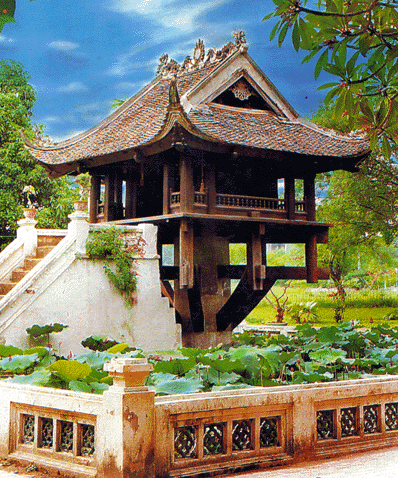A zealous peasant rebellion in Vietnam rose up under the popular Tran Cao in the spring of 1516. Believed by some to be a Taoist sorcerer clad in his crimson robes, Tran Cao began gathering his warriors at the Quynh Lam Pagoda. He declared that he was the avatar of the god Indra, master of weather and warfare, and that this body was meant to rule as it had been born with links to both the ruling Le family and the previous dynasty, the Tran. His following expanded to form an army of ten thousand warriors that marched on the capital, Thang Long (later to be known as Hanoi).
As the massive peasant-army approached, the young emperor Le
Tuong Duc stood up to address his personal guard. Tuong Duc was the latest in a
line of disappointing emperors since the golden age under his grandfather, Le
Thanh Tong. Thanh Tong had come to power through invitation as a teenager in
1460 when a counter-coup knocked his half-brother from the throne. Through his
thirty-seven year rule, Thanh Tong instituted Confucian ideals into government.
He wrote the Hong-duc, a comprehensive and systematic law, ordered detailed
maps and a census, and personally toured the empire to alleviate issues with corrupt
local officials. While highly popular with the Vietnamese, Thanh Tong
notoriously opposed to outsiders, instituting isolation against trade and
repeatedly campaigning to conquer land to the south and west. Foreign sailors
who washed ashore in storms were castrated and impressed into military service.
After Thanh Tong’s death, his son Le Hien Tong continued the
Confucian kingship until 1504, but the cruel five-year rule of Le Uy Muc made
the imperial family very unpopular with peasants and nobles alike. He pitted
palace guards against one another like gladiators for his amusement while he
studied martial arts. Uy Muc’s cousin Tuong Duc, just fourteen years old,
organized the emperor’s assassination and seized power. He worked to bring back
the golden days of his grandfather, chasing out Uy Muc’s violent favorites and
filling the court with scholars. To emulate greatness, he began costly projects
like artificial lakes, pleasure palaces, and building an enormous harem that
included many of his father’s concubines (breaking both Confucian and
Vietnamese law). Heavy taxes to fund the projects spawned rebellions, and Tran
Cao was the latest in a series of disputes. Le Tuong Duc expected his soldiers
to put them down. Anyone who tried to show their disapproval was whipped,
including the captain of his guard, Trinh Duy San.
With only the river between the capital and the oncoming
army of rebels, Le Tuong Duc was suddenly shown the obvious errors of his ways
as his heavy taxes logically led to such rebellion. He broke down and confessed
his failures as a Confucian and emptied his harem, granting the wives to his
guard to make up for the pain he had caused them. If this infighting continued
as people acted beyond their positions, he predicted a Vietnam of weakness on a
national scale. If strength did not come from within, it would oppress them
from without.
Trinh Duy San swore his loyalty, and he led the defense as a
veteran of the 1511 rebellion, once fighting a battle down to the last thirty
men. The defenders attacked wherever the peasants attempted to make a beachhead
on the river, finally driving back their superior numbers with superior
weapons. Tran Cao fell in the battle, and the leaderless rebels dispersed.
Le Tuong Duc made good on his word, adhering to the law of his
grandfather and repealing taxes. As the economy recovered, he found resources
to organize more campaigns into the south against the growing power of the Tai
and maintain Vietnam’s independence from China. In Tuong Duc’s later reign, the
great general Mac Dang Dung stormed the lands of the dying Khmer Empire, conquering
huge swaths of which he was made governor. Children of major families were
brought to court schools and imbued with Confucian ritual and teaching: most
importantly, to uphold the emperor.
In the seventeenth century, European ships began to appear
on the coast. Portuguese and Dutch traders attempted to broker deals with
emperors, but the boarders remained largely closed. Some technology had to be
proven useful, such as the printing press that was installed to decrease
dependence on China. Firearms were strictly regulated. Foreign luxuries and
religions were banned, despite the efforts of French Catholic missionaries to
make inroads.
It was not until the nineteenth century that the warships of
the Kaiser opened Vietnam for trade with Germany, following the example of the
United States Navy in Japan. A flood of western technology and cheap manufactured
goods caused reprisals from locals suddenly being undersold. The German-Vietnam
War briefly turned the empire into a colony, but Germany’s collapse in World
War I liberated the country thanks to Woodrow Wilson’s vote of confidence at
Versailles. Japan similarly seized and lost control in WWII. Vietnam
transitioned to a constitutional monarchy supported by a vocal parliament with
members such as the outspoken Nguyen Ai Quoc, who gained his attitudes of
anti-socialism while being educated in Germany.
--

No comments:
Post a Comment